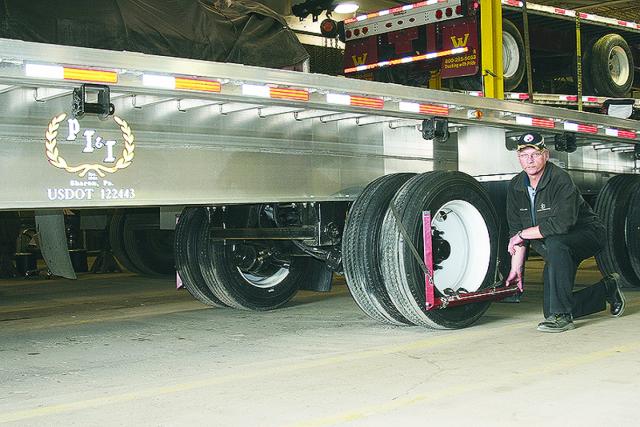Understanding Trailer Alignment

GIRARD, OHIO… Have you ever seen someone going down the road pulling a trailer that is tracking to the side? There is a man who is leaving a trail of money behind him. While calculating loss of fuel mileage is probably difficult, you will definitely know how much money you’ve lost when you go to replace your trailer tires prematurely. A trailer axle out of alignment as little as ¼ of an inch can cause the trailer to track to the side and make it nearly impossible to keep both tractor and trailer centered within your lane. Construction zones will really challenge your driving skills, maybe even upset a few people trying to pass you. What most drivers are not aware of is that if both axles are out of alignment, the trailer may track straight. While you might think everything is okay, the axles are working against each other, stealing horsepower from your tractor, while the tires are still scrubbing away. Unfortunately by the time you visibly see the trailer tires scrubbing, chances are the wear pattern has probably already gotten too severe. You will be buying new trailer tires before you have achieved a full service life from your present set.
Recently I had the opportunity to be educated about trailer alignment by John Carlson, Service Manager at Girard Equipment Company and Trailer Technician Steve Wayland. These trailer service professionals opened my eyes to some interesting facts and misconceptions about trailer alignment.
While all trailers come pre-aligned from the factory, over time the alignment can slip out of spec. Causes can be potholes, curbing the trailer or worn bushings. In extreme cases sometimes the axle or frame is bent, although about 90% of the time it is simply the trailer alignment.
Trailer axles have no easy toe or camber adjustment. The only adjustment is the “thrust angle,” which is the direction the axles are headed compared to the frame of the unit. Each axle has its own adjustment and alignment is even more critical with multi-axle configurations.
In the old days a guy would take a tape measure, go underneath the trailer and measure the distance from the king pin to the wheel. Adjustments were then made until both sides were equal. The problem with this method is that any variance, such as a bow in the tape or simply not measuring to and from the same exact points will equate to a large waste of your time. When you add in the fact that the majority of fifth wheel pins are not exactly centered (some can be off by as much as ¼”), a backyard alignment can become frustrating. Much like the simple plumbing job that turns into 3 hours and 4 trips to the hardware store, sometimes it’s better to call someone who knows what they are doing. At least with plumbing you know if your job works if no water is leaking.
For the past 18 years Girard Equipment Company has been providing their customers with exacting Protrak QCT Lasar Alignment. All of the technicians are trained to perform trailer alignments. The method is simple but effective. A lasar alignment yoke is fastened to each wheel. A plumb bob is dropped from the trailers side rail at the front of the trailer. A steel plate, marked in 1/8th inch graduations, is centered and aligned with the plumb bob. When the lasar is turned on, it will instantly show how much the axle is out of alignment. Newer trailers are quickly and easily adjusted with factory installed quick-align systems, older trailers will require more time. Each suspension requires a different adjustment method. With lasar alignment, however, the axle can be adjusted to a tolerance of 1/32 to 1/64 or basically about as good as it gets. Tandams and super singles are both adjusted in the same manner.
If you are checking your trailer for tracking while going down the road, remember that just about every road is built with a “crown” to facilitate water run off. This crown can cause some tracking and there is virtually no way to compensate for it. The only way to be absolutely sure about your trailer alignment is to have it checked. Checking the alignment will take about 45 minutes to an hour and costs a little over $50.00. John Carlson recommends that you have your trailer checked for your own piece of mind, especially if the trailer has been in service for a while. Girard Equipment will provide an alignment form with a diagram that will show the alignment specs. They will advise you as to what needs to be done to align the trailer, how long it will take and how much it will cost to adjust. If you like, you can take your alignment profile, go home and adjust the trailer yourself. If so, just remember your last plumbing job. The trained technicians at Girard Equipment will also do a visual inspection of the trailer suspension and let you know if you have any problems.
Peace of mind when it comes to your trailer is not as expensive as you think. Call John Carlson at 800-686-2575 if you have questions about your trailer alignment. Always remember, even if you don’t own the trailer, check the air pressure in the tires with a tire gauge before you hit the road. You might be surprised at how under inflated some trailer tires can be, and thumping will only find the ones that are severely under inflated. Even if the trailer belongs to someone else, the diesel fuel to pull it belongs to you, and air is still a lot cheaper than fuel.
